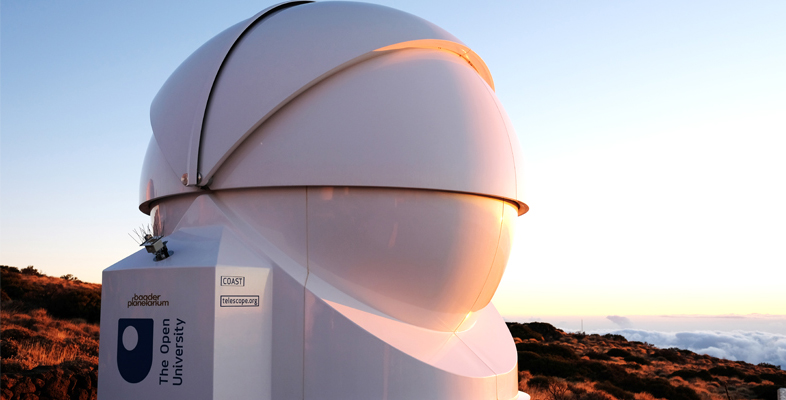PLEASE NOTE: After a hardware failure, COAST remains offline for now. All observing requests are being redirected to PIRATE. As Open University teaching and research commitments of PIRATE have to take priority, the observing time available for telescope.org requests is more limited and waiting times for images to return may be a little longer.
This free course, Astronomy with an online telescope, shows you how to navigate the night sky, and introduces the wide variety of objects it contains. You will develop a hands-on understanding of telescopic observations using the Open University’s
own robotic telescope facility COAST sited on the island of Tenerife. Supported by your own measurements we illustrate how stars evolve, and study variable stars.
For those new to astronomy and/or the use of robotic telescopes this course provides a practical introduction and will prepare you for further OU study where remotely operable telescopes feature. For those undertaking the GCSE Astronomy course or studying informally the series of structured activities this course contains will allow you to produce a beautiful image of a celestial object of your choice – and analyse the changing magnitude of a variable star over time (one of the approved aided GCSE Astronomy projects).


This course was also developed with the help of the ASTERICS Horizon2020 project. ASTERICS is a project supported by the European Commission Framework Programme Horizon 2020 Research and Innovation action under grant agreement n. 653477.

This course is accredited by the CPD Standards Office. It can be used to provide evidence of continuing professional development and on successful completion of the course you will be awarded 24 CPD points. Evidence of your CPD achievement is provided on the free Statement of Participation awarded on completion.
Anyone wishing to provide evidence of their enrolment on this course is able to do so by sharing their Activity Record on their OpenLearn Profile, which is available before completion of the course and earning of the Statement of Participation.
Enrolling on the course will give you the opportunity to earn an Open University digital badge. Badges are not accredited by The Open University but they’re a great way to demonstrate your interest in the subject and commitment to your career, and to provide evidence of continuing professional development.
Once you are signed in, you can manage your digital badges online from My OpenLearn. In addition, you can download and print your OpenLearn statement of participation – which also displays your Open University badge.
The Open University would really appreciate a few minutes of your time to tell us about yourself and your expectations for the course before you begin, in our optional start-of-course survey 3413456973. Once you complete the course we would also value your feedback and suggestions for future improvement, in our optional end-of-course survey 7074. Participation will be completely confidential and we will not pass on your details to others.
Earn this free Open University digital badge if you complete this course! The badge can be displayed, shared and downloaded as a marker of your achievement. The badge is awarded for completing the course and passing the quizzes.
Course learning outcomes
After studying this course, you should be able to:
- understand how the apparent motion of the night sky is caused by the rotation of the Earth and the movement of the Earth in its orbit around the Sun
- understand how the human eye adapts to dark conditions and how to use dark adapted vision to its best effect when observing the night sky
- have an understanding of the different types of telescopes and the advantages of an observatory location at a remote site such as Tenerife
- understand how the positions of celestial objects are specified and be able to use this knowledge to predict when a given object will be visible in order to plan observations and make and collect images from the COAST telescope in Tenerife
- understand the processes by which stars shine and how they evolve and the causes of variability in stars.
First Published: 22/10/2021
Updated: 22/10/2021
